RSTV PERSPECTIVE: RUSSIA-UKRAINE STANDOFF
CONTEXT: Russia-Ukraine crisis has led to increased global tension.
MORE ON THE NEWS:
- In the latest development, Russia has started 10 days of joint military drills with close ally Belarus, which has a long border with Ukraine. West fears that Russia could use Belarusian territory to invade Ukraine. Ukraine has termed it "psychological pressure".
- While France, which is trying to broker peace through negotiations with both countries, has also called the drills as a "violent gesture" by Russia.
- UK Prime Minister Boris Johnson has called it the biggest security crisis in decades.
- The US has warned that an attack from Russia could come at any time. Although Russia has repeatedly denied any plans to invade Ukraine.
- While diplomatic efforts are underway, NATO also has stepped up deployment of troops to bolster the alliance's eastern flank.
- The US has begun to move the 2nd Cavalry Regiment's stryker squadron from Vilseck, Germany, to Romania, which borders Ukraine.
- Turkish President visited his Ukrainian counterpart, saying he wants to play his part in establishing “an atmosphere of peace and trust in our region.”
WHAT ARE THE ROOTS OF THE RUSSIA-UKRAINE STANDOFF?
- Ukraine, which was part of the Russian empire for centuries before becoming a Soviet republic, won independence as the USSR broke up in 1991.
- The country has moved to shed its Russian imperial legacy and forge increasingly close ties with the West.
- A decision by Kremlin-leaning Ukrainian President Viktor Yanukovych to reject an association agreement with the European Union in favor of closer ties with Moscow sparked mass protests that led to his ouster in 2014.
- Russia responded by annexing Ukraine’s Crimean Peninsula and throwing its weight behind a separatist insurgency that broke out in Ukraine's east.
- Ukraine and the West accused Russia of sending its troops and weapons to back the rebels. Moscow denied that, charging that Russians who joined the separatists were volunteers.
- More than 14,000 people have died in the fighting that devastated Ukraine’s eastern industrial heartland known as Donbas.
- A 2015 peace agreement brokered by France and Germany helped end large-scale battles, but efforts to reach a political settlement have failed, and sporadic skirmishes have continued along the tense line of contact.
- Recent standoff began in mid-December when Russia told Western powers, including the US, that it had a list of demands.
- Russia wants a guarantee from the West “in writing” to stop any further eastward expansion of NATO, the removal of NATO troops from Poland and the Baltic states, and the possible withdrawal of US nuclear weapons from Europe. The most important of its demands included that Ukraine should never be allowed to join NATO.
- The US and the West have ruled this out.
WHAT DOES MOSCOW WANT?
- The Kremlin has accused Ukraine of failing to honour the 2015 peace deal and criticized the West for failing to encourage Ukrainian compliance.
- The agreement was a diplomatic coup for Moscow, requiring Ukraine to grant broad autonomy to the rebel regions and offer a sweeping amnesty to the rebels.
- Ukraine, in turn, has pointed to cease-fire violations by Russia-backed separatists and insists there is a continuing Russian troop presence in the rebel east despite the Kremlin's denials.
- Amid the recriminations, Russia has rejected a four-way meeting with Ukraine, France and Germany, saying it's useless in view of Ukraine’s refusal to abide by the 2015 agreement.
- Moscow has strongly criticized the U.S. and its NATO allies for providing Ukraine with weapons and holding joint drills.
- Putin ominously said a military attempt by Ukraine to reclaim the east would have “grave consequences for Ukrainian statehood.”
- Russian president has repeatedly described Russians and Ukrainians as “one people” and claims that Ukraine has unfairly received historic Russian lands during Soviet times
- Putin says NATO may use Ukraine as a launchpad for missiles targeted at Russia.
- Some observers interpret the troop build-up as a demonstration by Putin that Russia is prepared to raise the stakes to convince NATO to respect Moscow’s red lines and stop sending troops and weapons to Ukraine.
WHAT IS THE US' ROLE IN THESE TENSIONS?
- The Cold War ended 30 years ago but one unresolved issue — how closely Ukraine can ally with the West — is now creating some of the deepest US-Russian tensions in years.
- For the United States and the European Union, Ukraine is a crucial buffer between Russia and the West.
- As tensions with Russia rise, the US and the EU are increasingly determined to keep Ukraine away from Russian control.
- The leaders of France, Germany, Italy, Britain and the United States expressed "determination" that Ukraine's sovereignty should be respected.
- The leaders all stressed the need for Russia to re-engage in negotiations with Ukraine, as part of the "Normandy Four" group under the aegis of France and Germany.
- The United States was ready to boost its military presence in Eastern Europe should Moscow invade Ukraine.
WHAT ARE THE HISTORICAL CONNECTIONS?
- Russia and Ukraine had been linked since the 9th century when Kyiv became the capital of the ancient state of Rus.
- From 1654, the two were united by treaty under the rule of the Russian tsar.
- They speak closely related languages and later formed, with Belarus, the Slav core of the Soviet Union.
- It was during the mid-19th century when, in order to accommodate the rising Ukrainian national movement, Russian imperial thinkers formulated a concept of the tripartite Russian nation consisting of the Great Russians, Little Russians, or Ukrainians, and the White Russians, or Belarusians.
- When the Tsar’s empire collapsed after the revolution led by Lenin, the Ukrainians created a state of their own and declared independence in January 1918.
- Although it turned out to be short-lived as the Bolsheviks took control over most of Russian Ukraine in 1920, that two-year period planted the seeds of independence among the Ukrainian people.
- It was the Ukrainian referendum of December 1 1991, in which over 90% of participants voted to leave the USSR, that spelt the end of the Cold War superpower.
IS THERE A GEOGRAPHY AND RESOURCE ANGLE TOO?
- After Russia, Ukraine is the second largest country in Europe too.
- It has major ports on the Black Sea and shares borders with four NATO countries.
- Europe depends on Russia for about one third of its natural gas – providing enormous leverage for Putin in any dispute with the West – and one of the main pipelines passes through Ukraine. Controlling this Ukrainian territory would enhance Russia’s pipeline security.
WHERE DOES INDIA STAND ON THIS?
- Indian response: Call for a peaceful resolution of the situation through sustained diplomatic efforts for long term peace and stability in the region and beyond.
- With key strategic partners on both sides, India can’t afford any hasty moves hurting its vital stakes.
- While there is concern about Russia’s “muscle-flexing”, Delhi does not want to jeopardise its close military ties with Moscow, particularly amid the stand-off with China on the eastern border.
- India is indeed conscious that the hostility between the West and Russia may push Moscow in the direction of Beijing.
- There is an Indian community in Ukraine, mostly students in medical colleges.
- When Russia had annexed Crimea, India had expressed “concern” but also qualified it by talking of “legitimate Russian interests”.
- Keeping in mind its ties with Russia, sources said, India hasn’t issued any condemnatory statements as is being done by the Western powers.
- For now, Delhi is hoping that the situation will be resolved by skilled negotiators on both sides.
PROTESTS IN UKRAINE:
- Euromaidan Movement: Euromaidan (European Square) was a wave of demonstrations and civil unrest in Ukraine, which began in November 2013 with public protests in Maidan Nezalezhnosti ("Independence Square") in Kyiv, Ukraine. The protests were sparked by the Ukrainian government's decision to suspend the signing of an association agreement with the European Union, instead choosing closer ties to Russia and the Eurasian Economic Union.
- Separatist Movement: The Donbass region (the Donetsk and Luhansk regions) of eastern Ukraine has been facing a pro-Russian separatist movement since 2014.
MINSK AGREEMENTS:
- Minsk I: Ukraine and the Russian-backed separatists agreed a 12-point ceasefire deal in the capital of Belarus in September 2014. Its provisions included prisoner exchanges, deliveries of humanitarian aid and the withdrawal of heavy weapons. The agreement quickly broke down, with violations by both sides.
- Minsk II: In 2015, an open conflict was averted after the ‘Minsk II’ peace agreement was signed, under the mediation of France and Germany. It was designed to end the fighting in the rebel regions and hand over the border to Ukraine’s national troops. It was signed by Representatives of Russia, Ukraine, the Organisation for Security and Cooperation in Europe (OSCE) and the leaders of two pro-Russian separatist regions.
WAY FORWARD
- A practical solution for the situation is to revive the Minsk peace process.
- Therefore the West should push both sides to resume talks and live up to their commitments as per the Minsk agreement to restore relative peace on the border.
- The tension on the Russia-Ukraine border represents a major security crisis for the region, with the potential to snowball into a broader conflict.
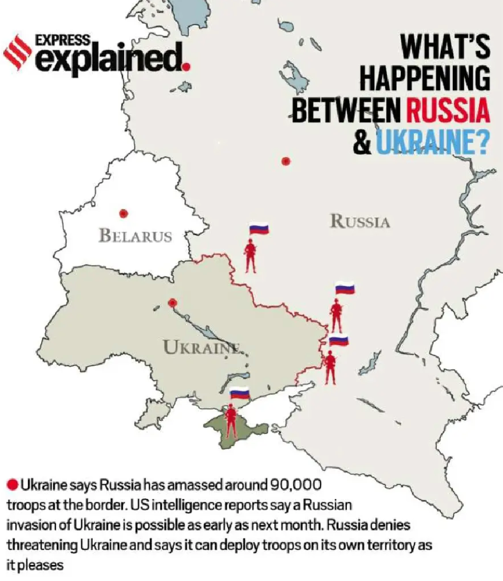
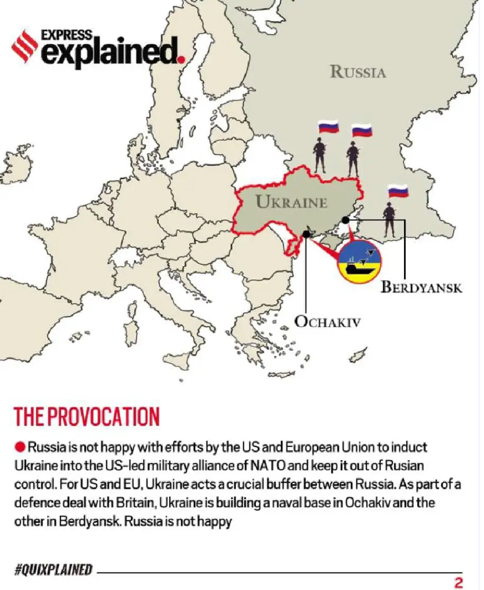
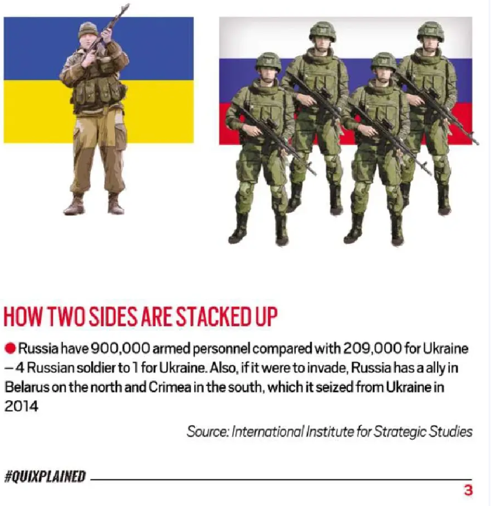
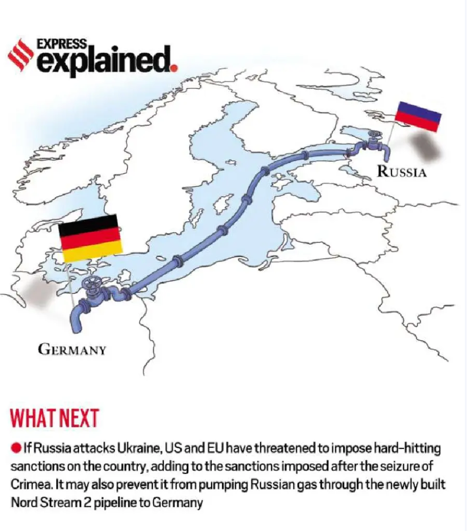
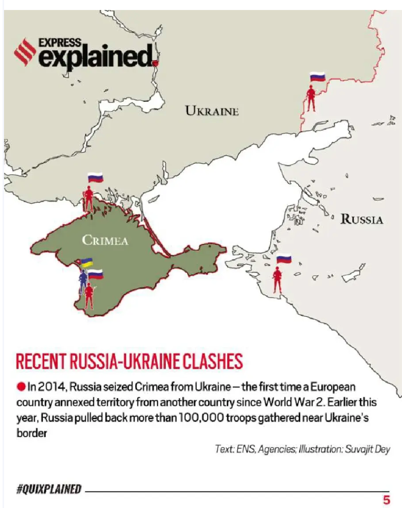
https://youtu.be/lsbP_XPrRss
https://www.firstpost.com/world/explained-what-you-need-to-know-about-ukraine-russia-tensions-and-us-role-in-the-standoff-10194431.html
https://indianexpress.com/article/explained/explained-ukraine-russia-and-india-7748911/
https://indianexpress.com/article/explained/why-russia-ukraine-border-tension-may-lead-to-broader-conflict-7659613/
https://indianexpress.com/article/explained/ukraine-russia-crisis-what-to-know-about-rising-fear-of-war-7755601/








